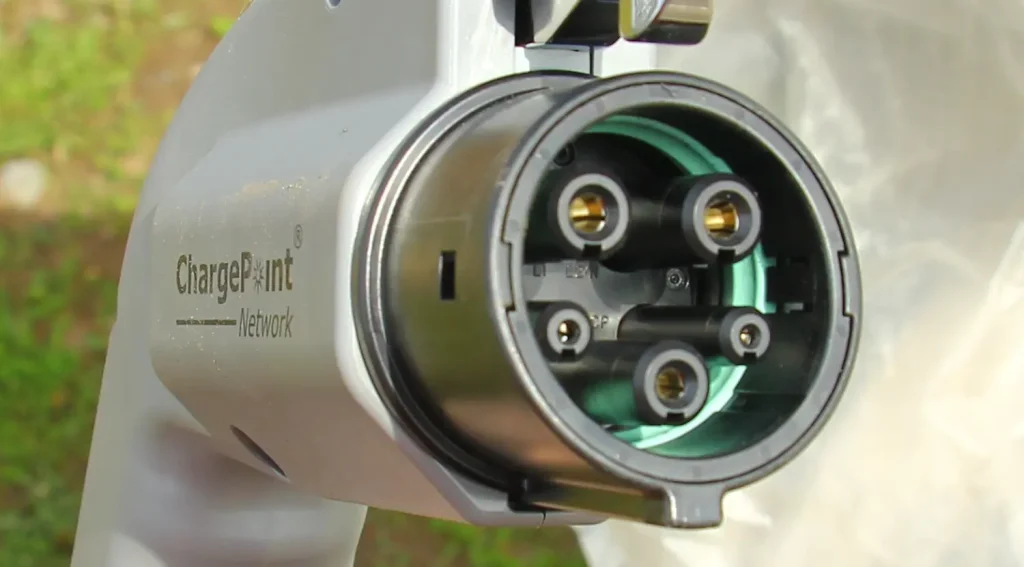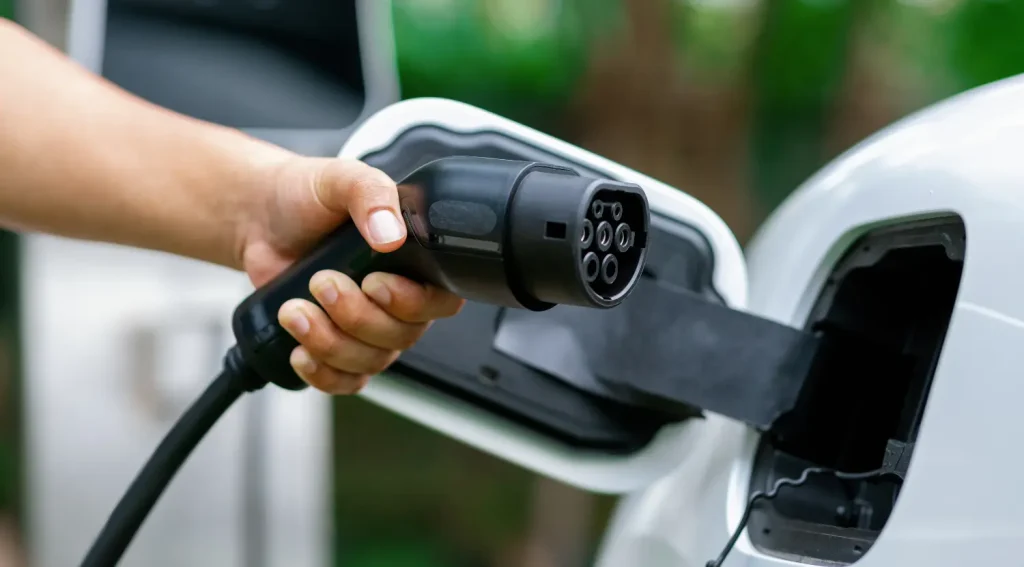
Learn how the J1772 EV Charger powers nearly every non-Tesla electric vehicle in the U.S., how fast it charges, and why it still matters in the NACS era.

So, you’re diving into the world of electric vehicles, and you keep seeing one term everywhere: J1772.
It’s on public charging stations, it’s the plug on home chargers, and it’s (probably) the port on your car.
But what is a J1772 EV Charger, exactly?
We’d say it’s been the single most important piece of charging hardware in North America for the last decade. In this guide, we’ll break down precisely what a J1772 ev charger is, how it works, how fast it really is, and, perhaps most importantly, what its future looks like in a world that’s suddenly talking all about NACS.
Long story short: if you own a non-Tesla EV, this is the plug you need to understand.
What Is J1772?

SAE J1772 is the technical standard for the plug that every non-Tesla automaker in North America (and Japan, for that matter) has agreed to use for Level 1 and Level 2 AC charging.
Now, we tend to call the whole wall box a ‘charger,’ but to be precise, the J1772 plug is part of the EVSE (Electric Vehicle Supply Equipment). Its job is to safely deliver AC power. The actual charger is a device inside your car that converts that AC power to DC to fill the battery. A nerdy distinction? Perhaps. But it’s key to understanding charge speeds later.
It’s the standard from the Society of Automotive Engineers (SAE) that ensures interoperability. Hence, it’s the simple reason why a Ford can use a ChargePoint station, and a Rivian can use a JuiceBox, and so on. It creates a common language for AC charging.
The Plug Itself: A Look at the J1772 Pin Configuration

You’ve seen the plug—that round, 5-pin connector that clicks into place with a latch on top. It looks simple, but those five pins are doing a lot of work to make charging safe and smart.
Let’s break down what each pin does:
● L1 (AC Line 1) & L2/N (AC Line 2/Neutral): These are the two big pins. They’re the workhorses delivering the power. For Level 1 charging (a standard 120V household outlet), one is ‘hot’ (L1) and one is ‘neutral’. For Level 2 charging (240V, like your dryer), both are ‘hot’ (L1 and L2).
● PE (Protective Earth): This is the essential ground pin. It’s a non-negotiable safety feature, just like the third prong on your home appliances, protecting you and the car from short circuits.
● PP (Proximity Pilot): This is a clever one. It’s a simple signal that tells the car “a plug is connected.” More importantly, when you press the latch on the handle to unplug, this signal is interrupted first. This tells the car and station to immediately stop the flow of power before the main power pins disengage. No sparks, no danger. It’s a key part of the safety design.
● CP (Control Pilot): This is the brain. It’s the communication line. The station uses this pin to send a signal (a 1 kHz square wave, for the curious) telling the car the maximum amps it can safely provide (e.g., “I am a 32-amp station”). The car then uses this same pin to signal back, “I’m ready to charge,” or “I’m full, stop sending power.” This digital handshake is what makes the whole system smart and safe.
Performance: Amps, Rates, and Real-World Charge Times
This is where the practical questions come in. How fast is it?
How many amps does a J1772 charger support?

What is the maximum charge rate for J1772?
At 80 amps and 240 volts, that’s a maximum charge rate of 19.2 kW. That’s incredibly fast for AC charging. That said, you’ll barely ever see an 80-amp station. They are rare and, honestly, overkill for most residential use. On top of that, very few cars can even accept that much AC power.
The reality is that most public Level 2 stations and home chargers you buy are either 32-amp (delivering 7.7 kW) or, increasingly, 48-amp (delivering 11.5 kW). This has been the sweet spot for a while.
So, how long does a J1772 ev charger take to charge an EV?
This is a common question. The J1772 standard itself can actually handle a lot—all the way up to 80 amps.
Well, this is where it gets complicated. The charge time is always limited by the “weakest link” in the chain: either the station’s output or your car’s onboard charger.
Your car has a maximum AC charge rate it can accept. A Ford Mustang Mach-E, for example, can take 11.5 kW. But a Chevy Bolt is limited to 7.7 kW (on older models) or 11.5 kW (on newer ones). A plug-in hybrid like a RAV4 Prime might only accept 3.3 kW.
● A Quick Tangent: You can plug that 3.3 kW PHEV into a powerful 11.5 kW station… but it will still only charge at 3.3 kW. The car is the bottleneck. This is, in fact, the most common point of confusion for new owners. You can’t force-feed a car more power than its internal charger was designed for.
Here are some real-world examples of range added (which is, honestly, a more useful metric):
● Level 1 (12-16A @ 120V): ~3-5 miles of range per hour. (Good for PHEVs or just topping off overnight).
● Level 2 (32A @ 240V / 7.7 kW): ~25-30 miles of range per hour. (The most common home setup and perfect for a full charge overnight).
● Level 2 (48A @ 240V / 11.5 kW): ~35-40+ miles of range per hour. (Ideal for quickly refilling long-range EVs overnight).
J1772 vs. The World: Other Plugs and Standards

J1772 does not exist in a vacuum. You’ve probably seen other, stranger-looking plugs.
Here’s how they all relate.
Difference between J1772 (Type 1) and Type 2
This one’s simple: geography. The J1772 plug we use here in North America is technically Type 1.
Type 2 (or ‘Mennekes’) is the standard plug in Europe. It looks different (it has 7 pins) and can handle 3-phase power, which is common in European homes. They are not compatible, but you would not find Type 2 here. So, for all practical purposes, ‘J1772’ means ‘Type 1’.
J1772 vs. CCS (Combined Charging System)
This is not a ‘vs.’ battle. Look at the port on most new EVs (like an Ioniq 5 or ID.4). You’ll see the round J1772 port on top, with two massive pins below it.
That entire thing is the CCS port. CCS simply ‘combines’ the J1772 plug (for AC charging) with two giant pins for high-speed DC Fast Charging. When you plug in a J1772, you’re just using the top part. When you plug in a CCS fast charger, it uses all the pins.
J1772 vs. CHAdeMO
CHAdeMO is the other DC fast-charging standard. It’s that big, round plug found on Nissan Leafs and Mitsubishi Outlanders. It’s a completely separate plug and standard from J1772/CCS. It’s also being phased out in North America; CHAdeMO-port cars are, frankly, a dying breed.
J1772 vs. NACS (The Tesla Plug)
And here’s the big one. For years, Tesla used its own sleek, proprietary plug (now called NACS) for everything—AC and DC. Non-Teslas used J1772. Teslas came with a J1772 adapter. It was, you know, a bit of a divide. This brings us to…
Which EV Cars Use J1772?
As of today? It’s easier to ask who does not.
The “Yes” List (Battery Electric Vehicles): Ford Mustang Mach-E, Chevrolet Bolt, VW ID.4, Hyundai Ioniq 5, Kia EV6, Rivian R1T/R1S, Polestar, Nissan Ariya… literally every non-Tesla battery-electric vehicle sold in North America uses the J1772 port for its AC charging.
The “Yes” List (Plug-in Hybands): It’s also the standard for all Plug-in Hybrids, like the Toyota RAV4 Prime, Chrysler Pacifica Hybrid, and so on.
The “No” List: Tesla. That’s it. And even then, every Tesla comes with a J1772 adapter in the trunk, so they can use the entire J1772 network just fine. They just need the adapter.
The Big Question: Is a J1772 EV Charger Being Phased Out?

This is the elephant in the room. In a shocking 2023 move, Tesla opened its NACS standard, and almost every other automaker (Ford, GM, Rivian, Hyundai, etc.) announced they will adopt the NACS port in their North American EVs, starting around 2025.
So, is your new Home J1772 EV charger a paperweight?
We’d argue: no. Not for a very, very long time.
Here’s why it’s sticking around:
- Legacy Cars: There are millions of J1772-equipped cars on the road today. They will be in use for 10-15 years.
- Legacy Infrastructure: There are hundreds of thousands of public and home chargers already installed with J1772 plugs. These would not be ripped out overnight.
What will happen is a gradual transition. For a while, we’ll be living the ‘adapter life.’ New NACS-port cars will use a simple J1772-to-NACS adapter (which they’ll probably come with). And old J1772-port cars (like the one you might own now) will need a NACS-to-J1772 adapter to use new Tesla-style chargers. It’s just a new plug, not a new charging technology.
The verdict? J1772 is being succeeded, not made instantly obsolete. It is still 100% well worth installing a J1772 EV charger today. It will serve you well for the entire life of your current EV and, with an adapter, likely your next one too.
In Closing
To sum up, the J1772 plug has been the quiet, reliable, and frankly, un-glamorous workhorse of the EV revolution. It’s the universal standard that made the entire non-Tesla charging ecosystem possible, handling all your crucial daily Level 1 and Level 2 charging.
That being said, its time as the only standard is coming to an end. But don’t let that worry you. The transition to NACS will be slow, and J1772 will remain a critical, functional part of the charging landscape for at least the next decade. Honestly, it’s the plug that built the industry as we know it.
